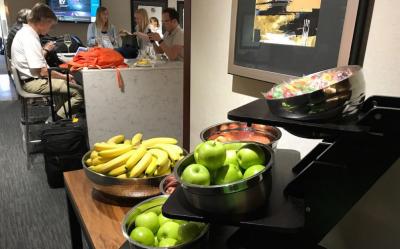But even as cuts continue, many carriers refuse to end lounge access. At these not-so-exclusive clubs, passengers often eat cheese cubes and crackers, sip cheap wine and fight for seating. Yes, most airlines have some nice clubs, usually at hubs, often reserved for long-haul business and first class travelers, but many more lounges are dreary, and uninviting.
Yet it’s remarkable how much passengers want to visit rooms with worn furniture, forlorn buffets, and coffee tables filled with empty plates and cups. In the United States, travelers often pay for memberships, mostly for at least $500 per year, while in Europe and elsewhere, mid-level elite frequent flyers and business class passengers get in free. Some banks also grant lounge memberships as part of a credit card’s annual fee.
Airline executives might prefer it otherwise. Some airlines probably can make lounges money-makers by selling a lot of memberships, opening clubs to passengers from other airlines, using these facilities to entice more travelers to apply for airline-branded credit cards, or joining Priority Pass, a network of more than 1,000 lounges worldwide. Priority Pass pays an airline each time a member enters.
But in the aggregate, it seems unlikely clubs are major revenue producers, since carriers not only must operate their lounges, but also must pay others to accept their passengers where they do not have one.
Still, British Airways has not touched the perk even though it has been on a cost-cutting binge, with short-haul business class passengers sitting in seats with 30-inch pitch, same as Ryanair in coach. British Airways even charges many short-haul business class passengers to choose a seat in advance, and prices start at about 20 pounds ($27.50).
But buy a British Airways Club Europe ticket from London to nearly anywhere in Europe, and you’ll visit a departure lounge for free. You’ll also get access if you’re a mid-level elite frequent flyer on British Airways, or one of its partners, including American Airlines. This is not an insignificant expense for British Airways, or its partners.
A few carriers seek to reduce lounge expenses. SAS recently cut lounge access at some airports, mostly in secondary European cities, because it no longer wanted to pay third-party operators to accept its customers. In the United States, JetBlue Airways does not have lounges, even for travelers flying in its Mint business class. It is a competitor for American, United Airlines and Delta Air Lines, all of which offer club access for flights from New York to Los Angeles and San Francisco.
If they could get away with it, more airlines probably would cut lounge access, at least to some passengers, or at some airports. But passengers seem to demand it, and airlines may fear customers would defect to another airline or alliance if the perk disappeared.
What do you think it is about lounges? Why are they one of the few perks airlines seem reluctant to take away? And why do customers like these clubs so much?
Source: Brian Sumers, Airline Business Reporter for Skift || January 18, 2018 |||

